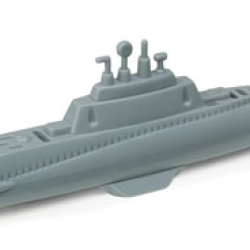Source Institutions
Source Institutions
Add to list Go to activity
Activity link broken? See if it's at the internet archive

Learners use a commercially available toy to experiment with density. They fill a chamber in the toy submarine with baking powder and release it into a tank of water. The material making up the submarine is more dense than water, so it dives at first. As the water reacts with the baking powder, gas bubbles are formed and lift up the submarine. When the submarine surfaces, it tilts and the bubble of gas escapes, so the submarine dives again. The whole process repeats until all the baking powder has reacted. A real submarine operates under the same density principles. This activity is part of the Chemistry of Toys unit in OMSI's Chemistry Lab. Cost estimates are for 100 uses.
- 5 to 10 minutes
- 5 to 10 minutes
- $1 - $5 per group of students
- Ages 4 - 14
- Activity, Experiment/Lab Activity
- English
Quick Guide
Materials List (per group of students)
- One 5-gallon plastic terrarium (store it with side displays)
- Diving Submarine toy (Manufactured by DaMert Company, San Leandro, CA) (keep three on hand)
- One 100-ml plastic beaker
- One metal scoop
- Miscellaneous small sea toys for “atmosphere”
- One small (6- to 12-oz) wide-mouth jar with lid
- Baking powder (keep two 7-oz cans on hand)
- One small plastic tray (about 5 in. by 7 in.)
- One 125-ml dropper bottle
- Experiment Operating Guide
Subjects
-
Engineering and Technology
-
Engineering
- Transportation Engineering
-
Engineering
-
Physical Sciences
-
Chemistry
- Chemical Reactions
- Acids and Bases
-
States of Matter
- Gases
-
Structure and Properties of Matter
- Volume and Density
-
Chemistry
Informal Categories
- Toys
- Transportation
Audience
To use this activity, learners need to:
- see
- touch
Learning styles supported:
- Involves hands-on or lab activities
Other
Components that are part of this resource:
This resource is part of:
Access Rights:
- Free access
By:
Rights:
- All rights reserved, Oregon Museum of Science and Industry, 1997
Funding Source:
- National Science Foundation
